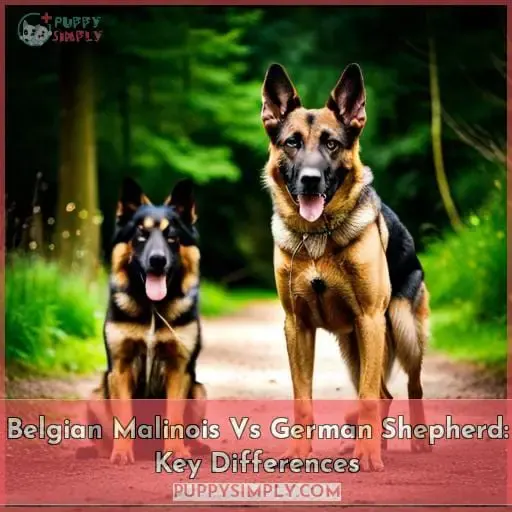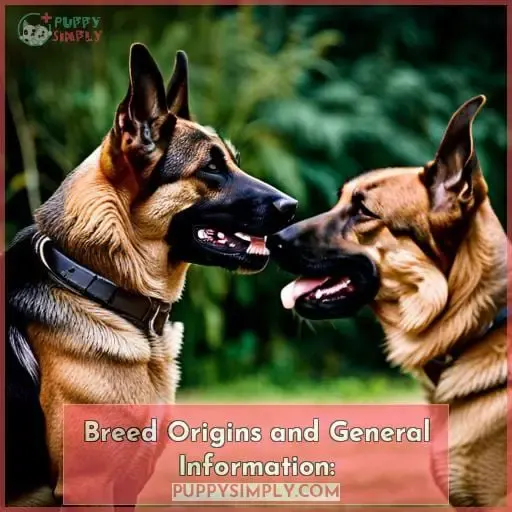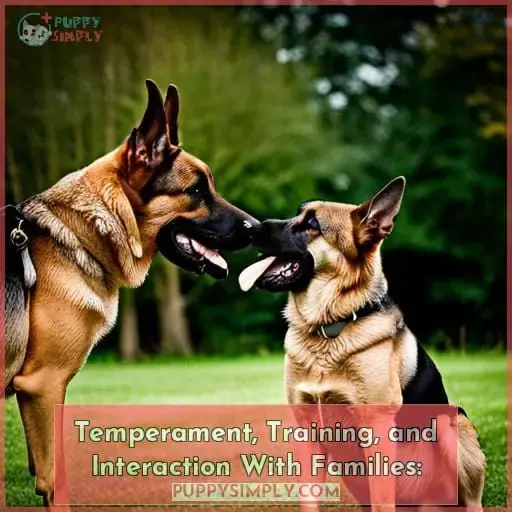This site is supported by our readers. We may earn a commission, at no cost to you, if you purchase through links.
 Imagine you’re standing in a room, faced with two powerful and intelligent dogs: the Belgian Malinois and the German Shepherd. Each breed has its own unique characteristics that set it apart from the other. In this article, we’ll explore these key differences to help you make an informed decision if you’re considering adding one of these remarkable canines to your life.
Imagine you’re standing in a room, faced with two powerful and intelligent dogs: the Belgian Malinois and the German Shepherd. Each breed has its own unique characteristics that set it apart from the other. In this article, we’ll explore these key differences to help you make an informed decision if you’re considering adding one of these remarkable canines to your life.
From their origins and physical features to temperament and working roles, we’ll dive into all aspects of Belgian Malinois vs German Shepherd comparison so that you have all the knowledge needed for mastery over your choice of companion or working dog.
Table Of Contents
- Key Takeaways
- Breed Origins and General Information:
- A Shared Herding Heritage:
- Lifespan, Physical Features, and Coat Characteristics:
- Size, Muscle Mass, and Physical Build:
- Temperament, Training, and Interaction With Families:
- Working Roles and Health Considerations:
- Popularity:
- Frequently Asked Questions (FAQs)
- Conclusion
Key Takeaways
- Belgian Malinois and German Shepherds have different origins and physical characteristics, with the Belgian Malinois being leaner and the German Shepherd having a bulkier appearance.
- Both breeds have a similar lifespan, but the Belgian Malinois tends to be healthier overall.
- The Belgian Malinois is highly trainable but requires experienced owners, while the German Shepherd is versatile and suits active families.
- Both breeds excel in working roles such as police, military, and search and rescue, but the German Shepherd is more popular due to media exposure.
Breed Origins and General Information:
Let’s start by exploring the breed origins and general information of Belgian Malinois and German Shepherds.
These two breeds come from different countries – Belgium for the Malinois, Germany for the German Shepherd. Understanding their origins is important in understanding their unique characteristics and traits.
Additionally, both breeds have distinct physical features, such as differences in size, muscle mass, coat coloring, and overall build.
Lifespan, Physical Features, and Coat Characteristics
When comparing Belgian Malinois and German Shepherds, you’ll notice distinct differences in their lifespan, physical features, and coat characteristics. Factors such as coat coloration, tail variations, training approaches, and health concerns contribute to these disparities between the breeds.
Lifespan
Belgian Malinois: 12-14 years
German Shepherd: 9-13 years
Physical Features
Belgian Malinois:
- Height: 22-26 inches
- Weight: 55-75 pounds
- Coat: Short, dense, and straight
- Color: Black, fawn, or mahogany with a black saddle
German Shepherd:
- Height: 22-26 inches
- Weight: 55-75 pounds
- Coat: Long, thick, and double-layered
- Color: Black, black and tan, sable, or white
Coat Characteristics
Belgian Malinois:
- The coat is short, dense, and straight.
- It sheds moderately throughout the year.
- The coat is easy to maintain with regular brushing.
German Shepherd:
- The coat is long, thick, and double-layered.
- It sheds heavily twice a year.
- The coat requires regular brushing to prevent matting and tangles.
Tail Variations
Belgian Malinois:
- The tail is naturally docked.
German Shepherd:
- The tail is either naturally long or docked.
Training Approaches
Belgian Malinois:
- The Belgian Malinois is a highly intelligent and trainable breed.
- They are best suited for experienced owners who can provide them with the mental stimulation and exercise they need.
German Shepherd:
- The German Shepherd is a versatile breed that can be trained for a variety of tasks.
- They are best suited for active families who can provide them with the training and exercise they need.
Health Concerns
Belgian Malinois:
- The Belgian Malinois is prone to a number of health conditions, including hip dysplasia, elbow dysplasia, and bloat.
German Shepherd:
- The German Shepherd is also prone to a number of health conditions, including hip dysplasia, elbow dysplasia, and bloat.
Size, Muscle Mass, and Physical Build
Moving on to the subtopic of Size, Muscle Mass, and Physical Build (Breed Origins and General Information:), let’s delve into how Belgian Malinois and German Shepherds differ in terms of their size, muscle mass, and physical build.
The lean yet muscular Malinois weighs 60-80 lbs while the bulkier Shepherd can weigh up to 90 lbs.
Temperament, Training, and Interaction With Families
Your Malinois’ eager-to-please nature thrives on routine, while your Shepherd’s independence prefers learning a variety of tasks. Understanding their temperamental nuances is crucial for effective training and navigating family dynamics.
Working Roles and Health Considerations
Regarding working roles and health, you’re likely aware that the Malinois is often more prized than the German Shepherd for police and military work thanks to its consistency and responsiveness, while the Shepherd remains an excellent option too but can become bored and stubborn more easily.
Both breeds have a strong herding instinct which contributes to their success as working dogs. However, it’s important to note that Belgian Malinois generally tend to be healthier compared to German Shepherds who are prone to various health conditions such as joint dysplasia, eye issues, chronic diarrhea, blindness, cancer, lupus, and diabetes.
Popularity
When considering the popularity of Belgian Malinois and German Shepherds, it’s important to note their breed origins and general information.
Factors such as media influence, breed trends, and training challenges contribute to their varying levels of popularity.
A Shared Herding Heritage:
When considering the Belgian Malinois and German Shepherd, it’s important to recognize their shared herding heritage.
Both breeds originated in different countries but were bred for herding purposes. Understanding this common background can help you appreciate their unique characteristics and make an informed decision when choosing between them as a pet or working dog.
Both Breeds Originated in Different Countries
Belgian Malinois and German Shepherds each have their own unique origins, stemming from different European countries but sharing a common herding heritage.
Despite originating in Belgium and Germany respectively, both breeds emerged from regional herding breeds valued for their working abilities rather than pedigree.
While their backgrounds vary, comparing these intelligent, driven herding dogs reveals shared traits rooted in their historical roles.
Belgian Malinois and German Shepherds Were Bred for Herding
Originally, you bred both the Belgian Malinois and German Shepherd for herding livestock before they later specialized in other working roles.
- Herding Origins: Both breeds have a strong foundation in herding, originating from Belgium (Malinois) and Germany (German Shepherd).
- Working Prowess: Their ability to work with livestock was highly valued, leading to their popularity as working dogs.
- Temperament Nuances: While both breeds share traits like intelligence and energy, there are subtle differences in temperament that make each breed unique.
- Physical Distinctions: From size variations to coat colors and ear shapes, these physical characteristics contribute to the distinct appearance of each breed.
Their shared history as herders laid the groundwork for their continued success today as versatile working dogs with high AKC registrations and growing popularity trends among dog enthusiasts seeking capable companions.
Understanding These Differences is Crucial When Choosing a Pet or a Working Dog
To choose the right pet or working dog, it’s crucial to understand the distinct differences between Belgian Malinois and German Shepherds in their shared herding heritage. This knowledge is essential for making an informed decision when it comes to pet selection or considering a canine companion with specific working pup prospects.
By understanding their herding heritage, you can ensure that your choice aligns with your needs and expectations, whether it be for family behavior, search and rescue operations, livestock dogs, or any other tasks you may require from them.
Lifespan, Physical Features, and Coat Characteristics:
You’ll find the Belgian Malinois typically lives longer than the German Shepherd, 12-14 years compared to 10-13 years.
Additionally, they differ in ear shape – the Malinois has triangular ears while the German Shepherd’s ears have pointy tips.
Their coat coloring also contrasts, with the Malinois showing a solid, blond or fawn color with a black mask and ears, but the German Shepherd displaying a wider variety of darker brown, blond, and black-sable combinations.
Lifespan: Belgian Malinois and German Shepherd
Lifespan comparison (Belgian malinois vs german shepherd)
Coat color variations (belgian malinois vs german shepherd)
Training approaches (belgian malinois vs german shepherd)
Ear Shape: Belgian Malinois and German Shepherd
Take a look at the distinct ear shapes of Belgian Malinois and German Shepherds.
The Malinois has triangular ears resembling alert triangles, contributing to their square build.
German Shepherds have classic pointed tips to their ears which stand erect when alert.
Structural differences in ear shape align with each breed’s distinct appearance and movement – the Malinois in their efficient square quickness and the Shepherd in their unique, flowing gait.
Coat Coloring: Belgian Malinois and German Shepherd
Belgian Malinois and German Shepherd coat coloring subtopic:
Your coat genetics produce quite distinct coloring between the breeds.
The Malinois sports a consistent fawn coat with trademark black mask and ears, while the German Shepherd exhibits greater variety in shades of black, brown, blond, and sable.
These differences affect grooming needs, blendability for various working environments, and contribute to the breeds’ iconic appearances.
Size, Muscle Mass, and Physical Build:
When examining the physiques of these two breeds, you’ll notice some clear differences.
The lean yet muscular Malinois stands shorter and weighs less than the larger, bulkier German Shepherd.
Additionally, the tail of the Belgian Malinois is angled while the German Shepherd has a distinctive, poufy tail.
Size and Muscle Mass: Belgian Malinois and German Shepherd
When comparing the size and muscle mass of these two breeds, you’ll notice that German Shepherds tend to be bulkier and more muscular than Belgian Malinois.
- German Shepherds have a larger frame and can weigh up to 90 pounds, while Belgian Malinois typically weigh between 60-80 pounds.
- The German Shepherd’s bulky physique gives them a stronger appearance compared to the leaner build of the Belgian Malinois.
- Due to their larger size, German Shepherds require more exercise to maintain muscle mass and overall health.
- Both breeds benefit from breed-specific training that capitalizes on their strength, agility, and energy levels.
Understanding these variations in size and muscle mass is crucial when considering factors like exercise requirements, breed-specific training needs for optimal development or behavioral variances due partly due genetic structure.
Tail Shape: Belgian Malinois and German Shepherd
You’ll notice that the tail shapes of Belgian Malinois and German Shepherds differ, contributing to their distinct physical builds.
The Belgian Malinois has a more angled tail, while the German Shepherd’s tail is poufy.
These variations in tail shape not only affect their appearance but also influence their movement characteristics and behavioral cues.
Tail position and expression differences can provide insights into a dog’s mood or intentions.
Breeders often adhere to specific breeding standards when it comes to selecting dogs with desirable tails for each breed.
Temperament, Training, and Interaction With Families:
When comparing the temperament, training, and interaction with families of Belgian Malinois and German Shepherds, there are several key differences to consider.
Both breeds possess a high level of intelligence and energy, making them ideal for working roles such as police or military work. However, Belgian Malinois tend to be busier and more challenging in terms of training due to their extremely high prey drive.
On the other hand, German Shepherds exhibit a slightly less intense temperament but still require regular exercise and mental stimulation to prevent boredom.
Independence and Training: Belgian Malinois and German Shepherd
In training and temperament, the Belgian Malinois and German Shepherd have distinct differences.
The Belgian Malinois is known for its eagerness to please and thrives on routine in training.
On the other hand, German Shepherds are more independent and prefer learning a variety of tasks.
When it comes to interacting with families, Malinois are emotionally aware but may need time apart from small children, while German Shepherds are patient and observant, generally more tolerant of energetic kids.
Understanding these variations is crucial when considering their suitability for different working environments or as family pets.
Family Interaction: Belgian Malinois and German Shepherd
As we delve into the topic of family interaction, let’s explore how Belgian Malinois and German Shepherds differ in their temperament, training, and overall interaction with families.
-
Emotional Sensitivity:
- Belgian Malinois are generally more emotionally aware and sensitive than German Shepherds.
- They may require time apart from small children to avoid becoming overwhelmed.
-
Training Dynamics:
- Both breeds are highly intelligent and trainable but have different training preferences.
- While Malinois thrive on routine, German Shepherds prefer learning a variety of tasks.
-
Child Interaction:
- German Shepherds tend to be more patient and observant around energetic children compared to the emotionally sensitive nature of Belgian Malinois.
Anxiety: Belgian Malinois and German Shepherd
When it comes to anxiety, both the Belgian Malinois and German Shepherd can be prone to developing this condition due to their high energy levels and mental capacity.
The Malinois in particular may experience separation distress and other anxiety issues if lacking structured routines or proper training to meet their needs.
Establishing leadership and providing sufficient physical/mental stimulation is key for both breeds in order to prevent or manage anxiety-related behavioral challenges.
Working Roles and Health Considerations:
When considering the working roles and health considerations of Belgian Malinois and German Shepherds, there are important factors to take into account.
Both breeds excel in various working roles, such as police work and military service. However, it’s worth noting that Belgian Malinois are prized for their consistency and responsiveness in these fields, while German Shepherds may become bored or stubborn compared to their counterparts.
Additionally, when it comes to health considerations, Belgian Malinois tend to be generally healthier overall compared to German Shepherds who are susceptible to a range of health issues including joint dysplasia and eye problems.
Working Dogs: Belgian Malinois and German Shepherd
Consider working dogs when choosing between the Belgian Malinois and German Shepherd breeds.
The Malinois is more prized for consistency and responsiveness in military, police, and dog training roles while the German Shepherd excels in these areas but may become bored and stubborn compared to the Malinois.
- Police K9
- Military Working Dog
- Search and Rescue
- Service Dog
However, the Malinois is often healthier and lives longer than the German Shepherd, which is prone to issues like chronic diarrhea, blindness, cancer, lupus, and diabetes.
Health: Belgian Malinois and German Shepherd
You’re looking at some key health differences between the breeds when choosing a working dog or pet.
The Belgian Malinois is generally healthier, while the German Shepherd is more susceptible to various health issues like chronic diarrhea, blindness, cancer, lupus, and diabetes.
It’s important to consider these factors when making your decision.
The comparative health analysis reveals that Belgian Malinois tend to have fewer health problems overall compared to German Shepherds.
However, both breeds require proper care and regular veterinary check-ups for optimal well-being throughout their lifespans.
Popularity:
When it comes to popularity, there are some key differences between the Belgian Malinois and the German Shepherd.
The Belgian Malinois has been gaining popularity in recent years, currently ranking as the 43rd most popular breed according to AKC registrations. This rise in popularity can be attributed to their appearances in TV shows, films, and increased exposure on social media.
On the other hand, German Shepherds have consistently remained popular for decades due to their versatility and courage as working dogs.
Belgian Malinois: Rising Popularity Due to Media Exposure
You’ll notice the Belgian Malinois gaining popularity and becoming more visible, attributed to recent appearances in TV, film, and greater exposure on social media that showcase their intense drive and work ethic.
This media influence has sparked a surge of interest in the breed as people witness their incredible abilities in action.
The rising trend isn’t only due to their impressive skills but also because they’re now being recognized for their potential in various canine careers such as police work, search and rescue operations, and even competitive sports.
As public perception shifts towards appreciating the capabilities of these remarkable dogs, training challenges arise for those who seek to harness their full potential.
German Shepherd: Consistently Popular and Versatile
Consistently popular and versatile, German Shepherds have captured the hearts of dog enthusiasts for decades. Their unwavering appeal stems from their remarkable versatility and steadfast courage. Renowned for their success in various roles, including police work, search and rescue missions, herding livestock, and as loyal family companions.
Despite being adored by many, German Shepherds do come with training challenges due to their intelligence and independent nature. Nevertheless, their endearing characteristics make them a beloved choice for those seeking a powerful yet trainable companion who can excel in numerous tasks with mastery and control.
Frequently Asked Questions (FAQs)
Which breed sheds more?
Belgian Malinois sheds more than German Shepherds. Regular grooming and brushing can help manage the shedding, but be prepared for a higher maintenance coat with the Malinois breed.
How much exercise does each breed need daily?
To maintain dominance over these highly energetic breeds, you must provide daily exercise that matches their boundless energy.
Like a roaring river needing to flow freely, Belgian Malinois and German Shepherds require vigorous activities to channel their power.
What kinds of health tests should responsible breeders perform?
Responsible breeders should perform health tests to ensure the well-being of Belgian Malinois and German Shepherds.
Tests may include:
- Hip and elbow evaluations
- Eye examinations
- DNA testing for genetic diseases
- Cardiac screenings
What grooming requirements does each breed have?
Belgian Malinois and German Shepherds have different grooming requirements.
The Malinois has a short, easy-to-maintain coat that requires regular brushing to control shedding.
German Shepherds have a longer double coat that needs more frequent brushing and occasional professional grooming to keep it healthy.
What is the typical purchase price from a responsible breeder for each breed?
For reputable breeders, expect to pay:
- $1,500-$2,500 for a Belgian Malinois puppy
- $1,500-$4,000 for a German Shepherd puppy
Price depends on:
- Breeding quality
- Lineage
- Titles
- Health testing
- Guarantees
- Actual demand
Carefully vet breeders on:
- Health
- Socialization
- Support services offered
- Overall responsibleness.
Conclusion
To sum it up, when considering the choice between a Belgian Malinois and a German Shepherd, it’s important to weigh the key differences between these two remarkable breeds.
While they share a herding heritage, each has its own unique characteristics in terms of lifespan, physical features, temperament, and working roles.
The Belgian Malinois is gaining popularity due to media exposure, while the German Shepherd remains consistently popular and versatile.
Ultimately, your decision should be based on your specific needs and preferences.













